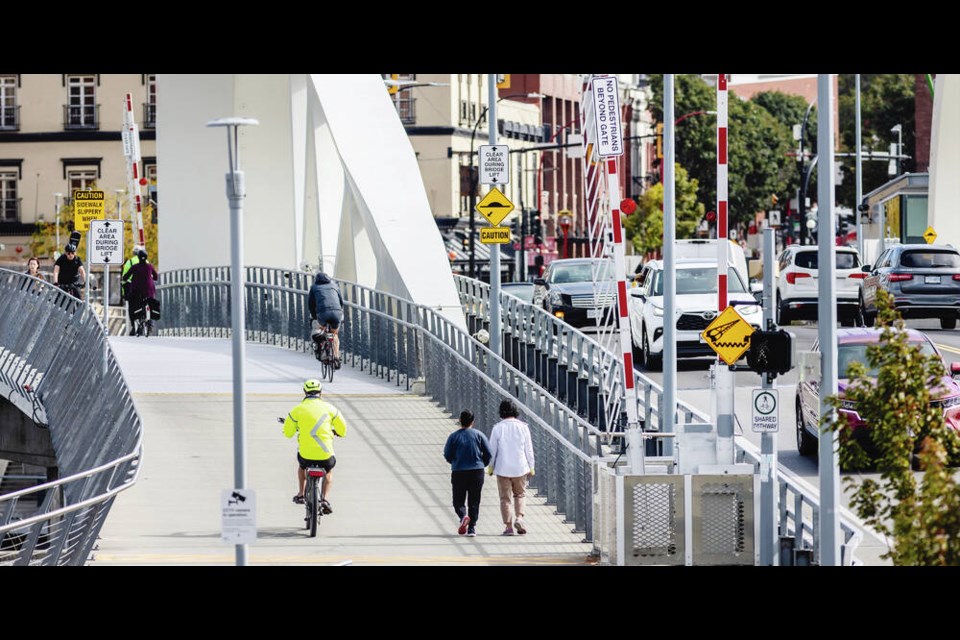Daily biking and walking trips continue to increase in Greater Victoria, the Capital Regional District’s latest every-five-years survey of travel patterns shows.
Though car use remains dominant — more than two-thirds of all daily trips are made by auto — the survey conducted by R.A. Malatest & Associates Ltd. shows a slight overall reduction of car use in the capital region, with more zero- and one-car households reported in 2022 compared with 2017.
In Victoria, less than half of daily trips were made by car. Active transportation makes up 43.6 per cent of daily trips, while car trips make up 46.1 per cent, with close to one-third of Victoria residents walking daily.
Ray Straatsma, who teaches a class on urban mobility at the University of Victoria, said that the results are not surprising, given that the city has been making investments in protected bike lanes and safer walking infrastructures.
“Victoria is just one of many, many cities all across North America who are catching on and making these kinds of investments [in] active transportation,” he said. “It just makes sense in the context of densifying urban areas.”
Canadian cities such as Vancouver and Montreal that have invested in substantial bike infrastructure have seen significant growths in active transportation share as a result, he said. “If it reaches into the neighbourhoods and it’s accessible, then people will start to ride more because they see the value of it.”
The survey, based on 8,581 household responses, found that motor-vehicle use in municipalities outside the core remains high, with four out of five trips made in cars. (The survey defines the core as Victoria, Saanich, Esquimalt, Oak Bay, View Royal, and the Esquimalt and Songhees First Nation urban reserves.)
Victoria Transport Policy Institute executive director Todd Litman, said that the results show that people will walk, bike, and take more public transport provided that it’s safe and convenient. “An awful lot of people would prefer to drive less.”
An assumption among urban planners for the last century was that everyone wanted to move out to automobile-dependent suburbs, Litman said. “All of our planning activities were designed around the idea that we need to invest in highways so people can move out to Langford and still come to the core community for work and shopping.”
“That is turning out to not be true,” he said, citing recent surveys and research that have found an increased preference for living in walkable urban neighbourhoods.
While Straatsma and Litman both acknowledge that the reduction in overall car trips may have been influenced by the changes to daily travel brought on by the COVID-19 pandemic, they said that they are expecting more people to walk, bike, and use transit in the future.
“If we allow more housing to be built in the walkable urban neighbourhoods, then this trend will continue. More people will live a what we call ‘car-light’ lifestyle,” Litman said.
According to the survey, transit share for daily trips have yet to recover from the pandemic. While transit share is higher in the core regions, the share falls off in the West Shore and Saanich Peninsula.
Ryan Windsor, chair of the Victoria Regional Transit Commission, said that Greater Victoria’s transit system is still faring better than most systems across Canada.
The transit commission is focusing on bringing rapid-bus routes to the Saanich Peninsula corridor, said Windsor, who is mayor of Central Saanich.
Municipalities have a part to play in ensuring that the transit experience measures up to other modes of travel, he said.
“A bus lets somebody off on Keating [Cross Road] and they’ve got to go up to Sean Heights. They basically walk up the side of Oldfield Road,” he said. “How can we make that experience better?”
“The ultimate goal for mode-share shift is that it’s faster and more convenient.”
>>> To comment on this article, write a letter to the editor: [email protected]



